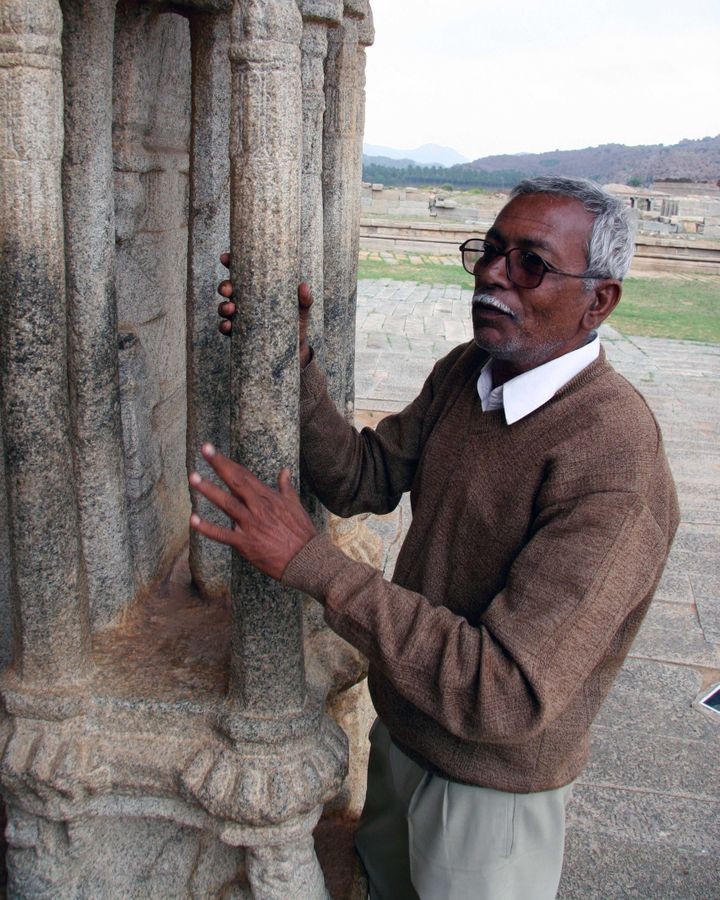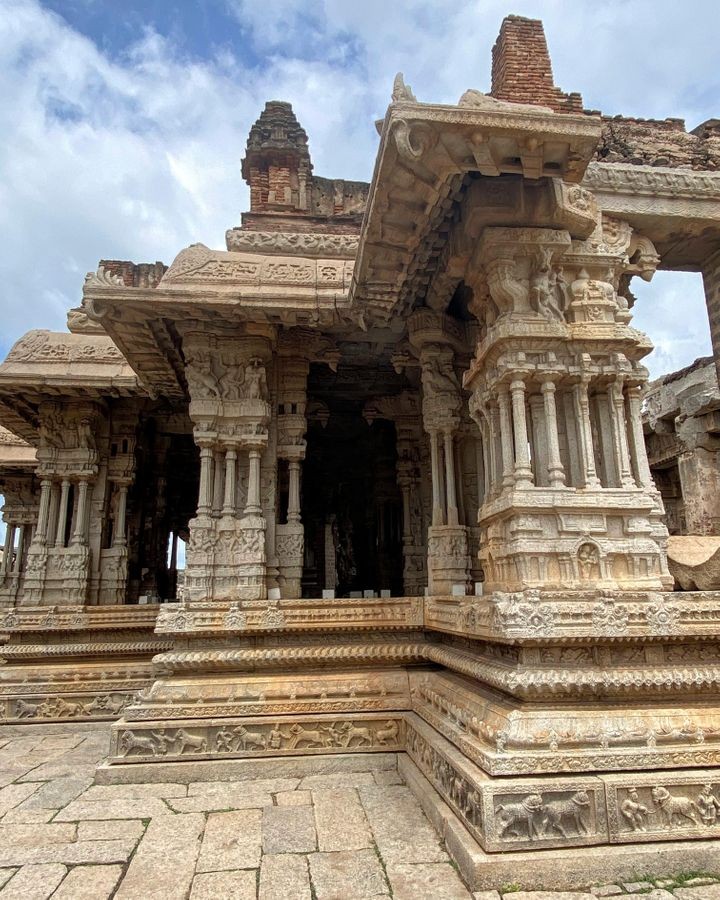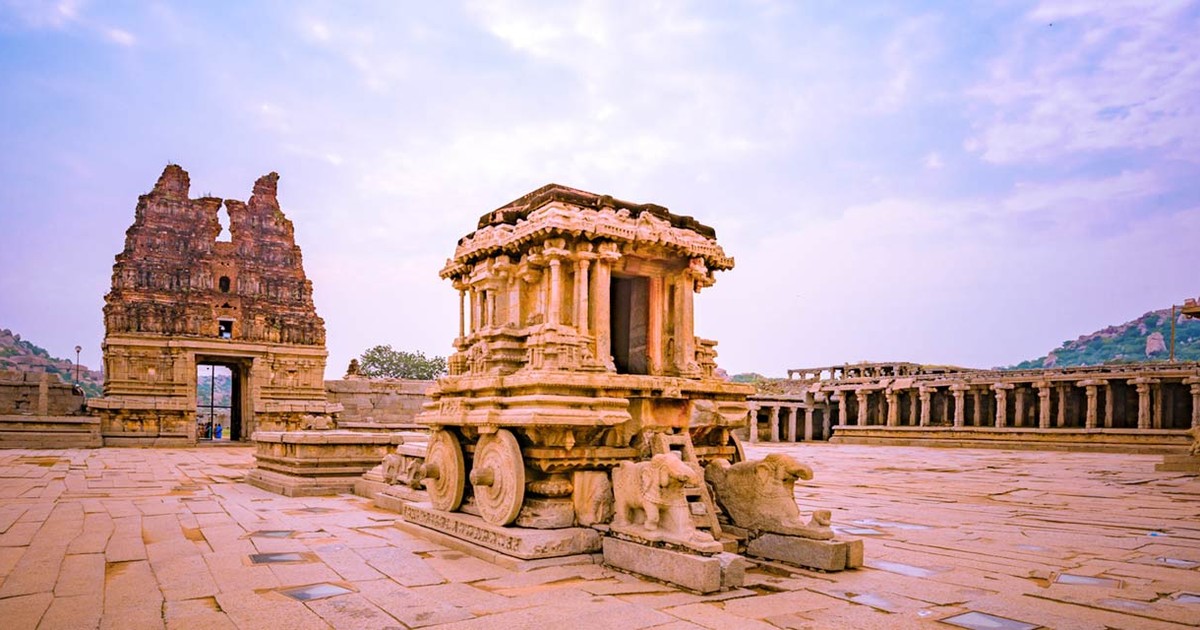Although carved from monolithic rock, the inside is not hollow, but the stone pillars of the Vijaya Vithala temple in Hampi, Southern India can emit wonderful music-like sounds when tapped. For 500 years, they have remained an unexplained mystery.
According to records from India, Vijaya Vithala was built in the 15th century, on the banks of the Tungabhadra River. At this time, Hampi was the capital of the Vijayanagara Kingdom. The kings of Vijayanagara were extremely devoted to Hinduism and passionate about art. They spared no time or money to build Vijaya Vithala with a vast campus, towering walls and beautiful temples.
Vijaya Vithala Temple worships Lord Vishnu, designed in the shape of a chariot. Today, Vijaya Vithala is only a ruin, but still retains its splendor.
Stepping through the entrance gate is a massive tower, located in the East with a spacious front yard, containing a stone carriage. True to its name, this “chariot” is carved from massive rocks, pulled by two elephants, and carved extremely delicately and in detail, both on the axle and on the wheel brakes.
The center of Vijaya Vithala is the Mahamandapa Great Hall. On the outside, Mahamandapa looks like a giant structure carved from a single block of rock but, in reality, it is made up of many blocks of stone.
All four sides of the Mahamandapa are open; The East, South and North still have the old architecture intact, the West has collapsed, possibly due to arson when Hampi fell in the past.
When Vijayanagara still existed, Mahamandapa was the most lavish stage, where the kingdom’s outstanding dancers presented beautiful performances to the gods and kings.
 |
| No one has yet explained why the stone pillars of Vijaya Vithala temple “can sing”. Photo: Alamy |
Traditional Indian musical instruments include string instruments and percussion. “Imagine you are standing in front of the Mahamandapa Great Hall during the prosperous Vijayanagara Kingdom, during a court music ceremony.
The dancers danced and sang passionately to the beautiful melodies emanating from the hands of wind, string and percussion musicians amid the magnificent scenery,” said Manjunath, a tour guide leading visitors into the “glorious old days.” .
“However, there were no musical instruments in the hands of the musicians. All they do is knock on the stone pillars,” Manjunath said, pointing to the pillars supporting the Mahamandapa Great Hall.
Mahamandapa has a total of 56 pillars and they are called by the common name, sa – re – ga – ma pillar, which means music pillar. Traditional Indian music includes 4 scales sa – re – ga – ma, corresponding to do – re – mi – pha.
“In the past, musicians used sandalwood sticks or their own hands to tap on the pillars. Just like that, they can create sounds as clear as a bell to as bustling as a drum,” Manjunath proudly said.
 |
| A corner of the Mahamandapa Great Hall with clusters of columns emitting a tonal scale of do – re – mi – pha. Photo: Malavika Bhattacharya, Bbc.com |
The Mahamandapa Great Hall stone column is designed in the form of a cluster of columns. Each cluster has a large, sturdy central column and many small columns around it. Ignoring the intricate carvings, they are no different from other stone pillars, all round, square, hexagonal or octagonal in shape, polished smooth.
Without knowing in advance that they could make sounds like musical melodies, no one would think of trying to tap them.
Initially, researchers thought that the inside of these stone pillars were hollow, which is why they had the music playing feature. However, after cutting a few trees for the purpose of deciphering the mystery, they confirmed that they were solid columns.
“In my opinion, the sa – re – ga – ma scale is formed from… stone material,” Professor Sharada Srinivasan guessed. Most of Mahamandapa’s columns are carved from large granite boulders.
“Because the granite is brought from different local quarries, the quality of the stone is also somewhat different. Plus the size of the thick, thin columns, round, square shapes… and placement, they emit different sound scales,” the Professor explained.
If Professor Srinivasan’s speculation is correct, then, from the beginning, Mahamandapa’s pillars were crafted for the purpose of being used as musical instruments. After careful observation, the professor discovered that there was a pillar carved with the image of a dancer holding a cymbal and the scale it emitted was as high as the cymbal. However, the other pillars and their carvings do not represent the musical scale they emit.
If Professor Srinivasan’s speculation is wrong then, in the first place, the pillars of Mahamandapa were just pillars. The fact that they emit sounds corresponding to the sa – re – ga – ma scale is simply accidental. Vijayanagara musicians only accidentally discovered it and then used it as a musical instrument.
For decades, out of curiosity, researchers around the world have come to Vijaya Vithala, tried tapping on the pillars and trying to explain its music.
Even tourists cannot contain their curiosity and try knocking with whatever object they are holding in their hands. As a result, they caused the column’s body to be chipped and forced the temple management board to issue a ban.






